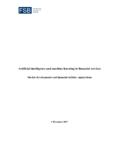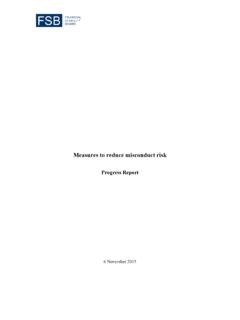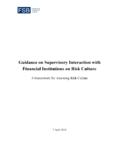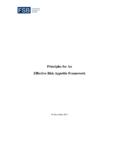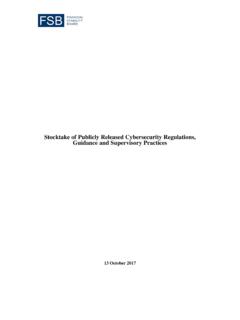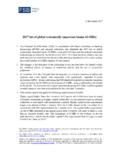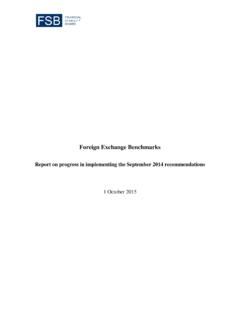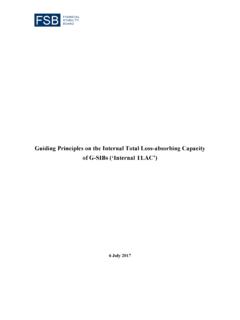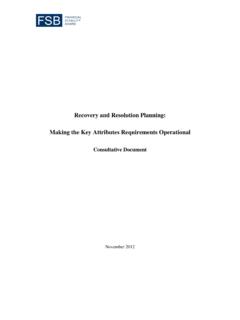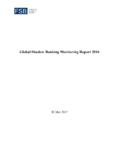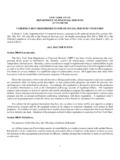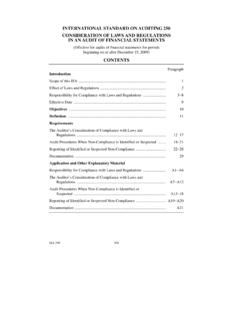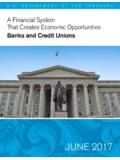Transcription of Summary Report on Financial Sector Cybersecurity ...
1 Summary Report on Financial Sector Cybersecurity regulations , guidance and supervisory Practices 13 October 2017 The Financial Stability Board (FSB) is established to coordinate at the international level the work of national Financial authorities and international standard-setting bodies in order to develop and promote the implementation of effective regulatory, supervisory and other Financial Sector policies. Its mandate is set out in the FSB Charter, which governs the policymaking and related activities of the FSB. These activities, including any decisions reached in their context, shall not be binding or give rise to any legal rights or obligations under the FSB s Articles of Association. Contacting the Financial Stability Board Sign up for e-mail alerts: Follow the FSB on Twitter: @FinStbBoard E-mail the FSB at: Copyright 2017 Financial Stability Board.
2 Please refer to: iii Table of Contents 1. Introduction .. 1 2. Summary of FSB Survey Conclusions .. 3 3. FSB Workshop on Cybersecurity .. 5 Effective Cybersecurity Practices .. 5 Effective Regulation and Supervision .. 6 Information Sharing .. 7 Capacity Building: Cybersecurity Expertise and Awareness .. 7 1 1. Introduction This is a Summary Report on Financial Sector Cybersecurity regulations , guidance and supervisory practices ( Summary Report ). Cyber attacks are a threat to the entire Financial system, a fact that is underscored by recent reports of significant and successful attacks both inside and outside the Financial Sector . The 2016 attack on the Bangladesh Bank resulted in the theft of $81 million, the WannaCry ransomware attack infected more than 250,000 computer systems in 150 countries, and the recent Equifax hack is estimated to have resulted in the compromise of personal information of up to 143 million The changing nature of cyber risk to Financial institutions is driven by several factors, including evolving technology, which can lead to new or increased vulnerabilities; interconnections among Financial institutions and between Financial institutions and external parties, through cloud computing and FinTech providers who may be outside the regulatory perimeter; determined efforts by cyber criminals to find new methods to attack and compromise IT systems.
3 And the attractiveness of Financial institutions as targets for cyber criminals seeking illicit Financial Recognising the threat from cyber risks and the critical nature of enhancing Financial institution resilience to those risks, authorities across the globe have taken regulatory and supervisory steps designed to facilitate both the mitigation of cyber risk by Financial institutions, and their effective response to, and recovery from, cyber attacks. The Communiqu issued at the March meeting of the G20 Ministers and Governors in Baden-Baden noted that the malicious use of Information and Communication Technologies could disrupt Financial services crucial to both national and international Financial systems, undermine security and confidence and endanger Financial The Ministers and Governors further noted that they would promote the resilience of Financial services and institutions in G20 jurisdictions against the malicious use of Information and Communication Technologies, including from countries outside the G20.
4 With the aim of enhancing cross-border cooperation, the Ministers and Governors asked the FSB, as a first step, to perform a stocktake of existing relevant released regulations and supervisory practices in G20 jurisdictions, as well as of existing international guidance , including to identify effective practices. The FSB was asked to deliver a stocktake Report ( Stocktake Report ) by October 2017. The FSB initiated the requested stocktake in early April of this year by distributing two surveys to its members for 1 See ; ; 2 For a discussion of cyber risk in the context of FinTech ( technology-enabled innovation in Financial services), see Financial Stability Implications from FinTech: supervisory and Regulatory Issues that Merit Authorities Attention, For an example of the evolution of attack methods see for detail on the release of the source code for the Mirai botnet and for detail on the predicted increase in Internet of Things devices.
5 For an outline of the high yield of recent attacks targeting the Financial Sector , see the section Targeted Financial heists , 3 See blob=publicationFile&v=3. 2 completion. One survey was directed to FSB member jurisdictions, and the second survey was directed to international bodies. The G20 request to the FSB was explicitly limited to released regulations , guidance and supervisory practices, and, as a result, the surveys were limited to publicly available materials. While regulations are typically published, supervisory practices may not be. supervisory practices that are in use, but that have not been publicly released, were not covered by the G20 request or the FSB survey and are not reflected in the Stocktake Report . In addition, the survey was limited to regulations , guidance and supervisory practices issued by government authorities in each jurisdiction; it did not cover any guidance , supervisory practices or similar materials that may have been issued by self-regulatory organisations.
6 The jurisdiction survey requested information about existing publicly released regulations , guidance and supervisory practices that address Cybersecurity for the Financial Sector , including Financial market infrastructures (FMIs), trading venues, banks, insurance companies, broker-dealers, asset managers and pension The international body survey asked about guidance that has been issued that addresses Cybersecurity for the Financial Sector , as well as other documents relating to Cybersecurity , including studies, surveys and reports. All 25 FSB member jurisdictions responded to the The nine international body members that received the survey also In addition, the G7 Cyber Expert Group submitted a response to the survey. In September of this year, the FSB held a workshop, which brought together public and private Sector participants to discuss Cybersecurity in the Financial Sector . Twenty-nine private Sector participants were drawn from across the Financial Sector and related industries, including banks, insurance companies, broker-dealers, asset managers, exchanges, clearing organisations, technology firms and Financial Sector industry groups.
7 The workshop provided senior officials from FSB members an opportunity to engage with chief information security officers (CISOs) and other senior leaders of firms concerning their views on effective practices in the area of Cybersecurity and ways that authorities may contribute to enhancing Cybersecurity throughout the Financial Sector . The workshop also provided a forum for members to discuss their experiences, across Financial sectors and jurisdictions, in regulation and supervision with respect to Cybersecurity . The FSB s Stocktake Report and this Summary Report are informed by the responses of member jurisdictions and international bodies to the FSB s surveys. The Stocktake Report explores existing publicly released regulations , supervisory practices and guidance in the area of Cybersecurity across the Financial Sector , including whether gaps exist and the degree of uniformity across the Financial Sector and FSB member jurisdictions.
8 The Stocktake Report includes information concerning jurisdictions self-reported existing publicly released 4 For purposes of the FSB survey, generally regulations and guidance were defined as materials that impose requirements on, or provide guidance for, regulated entities; and supervisory practices were defined as practices that supervisory authorities or regulators use in their oversight or examination of regulated entities. 5 The FSB member jurisdictions are Argentina, Australia, Brazil, Canada, China, France, Germany, Hong Kong, India, Indonesia, Italy, Japan, Korea, Mexico, Netherlands, Russia, Saudi Arabia, Singapore, South Africa, Spain, Switzerland, Turkey, United Kingdom, United States and the European Union. 6 This includes the Basel Committee on Banking Supervision, Committee on the Global Financial System, Committee on Payments and Market Infrastructures, International Association of Insurance Supervisors, International Accounting Standards Board, International Monetary Fund, International Organization of Securities Commissions, Organisation for Economic Co-Operation and Development and the World Bank.
9 3 regulations , guidance and supervisory practices; future plans; and views regarding effective regulatory and supervisory practices. The Stocktake Report also contains information regarding international bodies self-reported guidance , other publications and future plans. This Summary Report includes summaries of the conclusions from the FSB s stocktake survey and key themes raised in the discussion at the September workshop. 2. Summary of FSB Survey Conclusions The conclusions from the FSB s stocktake survey of members include the following. FSB member jurisdictions have been active in addressing Cybersecurity for the Financial Sector . All 25 member jurisdictions Report that they have publicly released regulations or guidance that address Cybersecurity for at least a part of the Financial Sector , and a majority have also publicly released supervisory practices. All or nearly all jurisdictions have addressed banks and FMIs, and a majority have addressed trading venues, insurance companies, broker-dealers and asset managers.
10 FSB member jurisdictions Report a significantly higher number of publicly released regulatory schemes than publicly released supervisory practices schemes. It is important to note, however, that some supervisory practices may not have been publicly released, and therefore were out of scope of the stocktake. International bodies also have been active in addressing Cybersecurity for the Financial Sector . The 10 international bodies that responded to the FSB survey reported published guidance covering electronic banking; FMIs; firms and supervisory and regulatory authorities throughout the Financial Sector ; critical information infrastructures, including Financial Sector actors that are critical information infrastructures; and all economic and social activities, across all sectors, from businesses, governments and individuals. All FSB member jurisdictions Report drawing upon a small body of previously developed national or international guidance or standards of public authorities or private bodies in developing their Cybersecurity regulatory and supervisory schemes for the Financial Sector .
